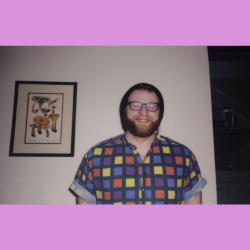With twenty-seven acts performing over the course of three nights in two venues, it was assured that you couldn’t see everything at Innipúkinn, even though you might want to. Since the rest of the city seemed hell-bent on getting out—barbecuing, communing with nature, or just getting fucked-up somewhere a bit more bucolic—I imagined those attending Innipúkinn would be the kind who felt no need to go far, who embraced the darkness indoors (and in themselves).
Innipúkinn literally translates as “Indoor Demon,” you guys. The term conveys something akin to an Icelandic couch potato, but with more angst and cooler hair (or so I imagine). Given the name, I expected something slightly demonic (or at the very least agoraphobic) about the festival—both of which I could get into.
It was therefore funny that the acts that fit my imagined theme for the weekend—Sin Fang, with his sad eyed whisper-singing; M-Band‘s slouching, solemn improvised noise-over-techno music; and Sóley, whose melancholic vocal loops alone I could listen to for days—were relatively sparsely attended. And those who did show up for those shows didn’t seem fully engaged. For Sin Fang and Sóley, who played at Húrra, attendees chatted amongst themselves as if they were back at the bar, or in their own living rooms. I’m talking non-stop banter, here—not just the occasional aside.
M-Band‘s Sunday set at Gaukurinn was loud enough that any chance for chatter was offset, but the crowd sure was thin. There was plenty of space between patrons to dance, though only one guy was really getting into it. No one stood at the front of the stage. Many didn’t stay through the whole set, preferring to come and go as they pleased. All three of these acts are talented, and under the right circumstances could easily captivate an audience—but there seemed to be something lacking in the crowd’s reception, enthusiasm, and energy.
Fucking party
The opposite was the case for Reykjavík hip-hop darlings Sturla Atlas and Gísli Pálmi. These guys were on fire. Or rather, the crowds were on fire for both of them. (And though I regrettably missed Icelandic lupine rap duo Úlfur Úlfur, I’d bet that the atmosphere was similar). The people of Innipúkinn had clearly had enough of dark, wrought, moody noise experimentation and riffs on solemnity. They wanted to fucking party. And since few, if any, major rap and hip-hop acts have regular tour stops in Reykjavík, these and other locally grown hip-hop acts serve to fill a huge pop-cultural void for concertgoers who have grown up cherishing recorded imports.
Sturla Atlas and entourage owned the stage with their brand of auto-tuned pop-hop (not meant in the derogatory sense) and factory-setting beats. There were potential moments of innovation—a few cool samples in “Lotta Girls,” and the slick rhythm of “Pills”—but mostly their sound was an agglomeration of their genre’s standard production and songwriting practices. That said, their stuff is catchy, which is an art in itself. On top of that, it’s fun to watch. All four guys on stage emitted high levels of energy, gesturing grandly and getting the crowd pumped by reminding everyone who they were between each song.
Then, when sunglasses-enthusiast Gísli Pálmi came on, things really got wild. Húrra was packed tight well past the double doors to the venue, and more kept piling in somehow. The man’s rhythm and flow were pretty solid, occasionally crossing over the realm of the excellent. His shirtless machismo and performative dominance weren’t too, too overdone; and his lyrics, though incomprehensible to me, were sonically interesting and rhythmically wild. I wonder, though: if I’d understood what he was saying, would I have enjoyed the set more or less?
High/low
The party spilled outdoors after Gísli’s set—when the beturfed Naustin was turned into an all-out block party thanks to Sturla Atlas and our dear, dear frenemy ethanol. This left DJ Introbeats’s set at Húrra under-attended.
The Sturla Atlas takeover and resulting block party was by far one of the highest points, and simultaneously the lowest point, of this year’s Innipúkinn. It reached great heights, because it carried over the killer vibes and high energy from their and Gísli Pálmi’s sets, and augmented it tenfold. On top of that, their second (and drunken third) performances were done sans autotune, which took away a sense of overproduction that had made their first seem not-quite-live-enough. The track list of their DJ set was packed with danceable hip hop, r&b, rap, and party hits. Good times and good vibes all around, save for the occasional shove-y drunk or rogue face-sucking couples.
The shared experience of that Saturday night (that went well into Sunday morning) was incredible, but there were some real problems lurking underneath. What brought the experience way, way down for me were the sheer number of intoxicated, lily-white twentysomethings gleefully singing along to each and every N-word blaring out of the speakers. It’s not a good look, guys; and it’s telling. It’s beyond the shady area of appropriation (which people argue back and forth on). It is a concrete example of why the Icelandic hip-hop scene, while jocular, lively, and often entertaining, is simultaneously insidious.
Rap and hip-hop acts are clearly what many in Reykjavík want—to experience in concert, and to produce as creatives. And it’s something many clearly respond to: the majority of Innipúkinn was out-shined by a single night of hip-hop. But does everyone know what they’re dealing with here?
It doesn’t appear so.
Buy subscriptions, t-shirts and more from our shop right here!




















